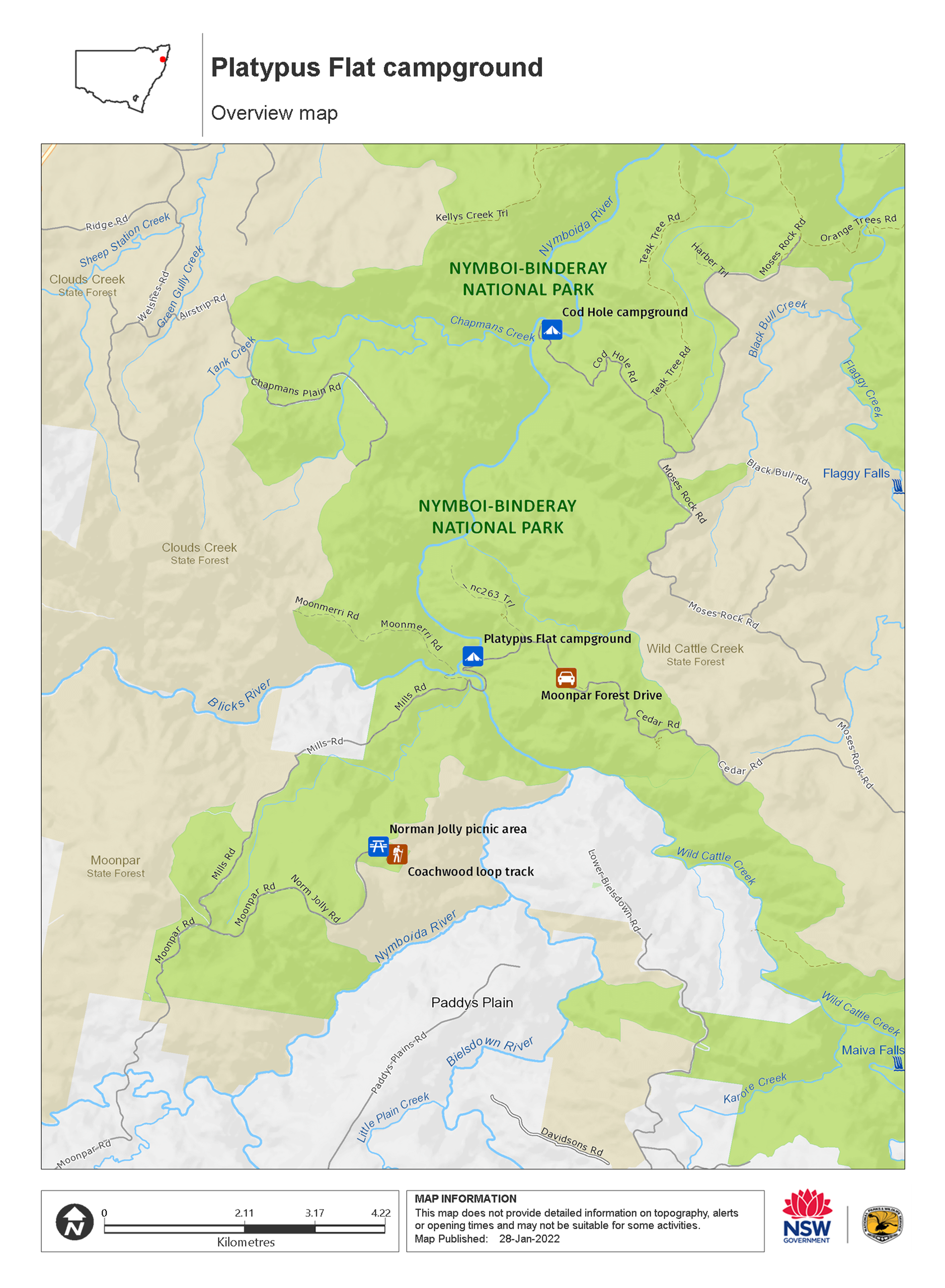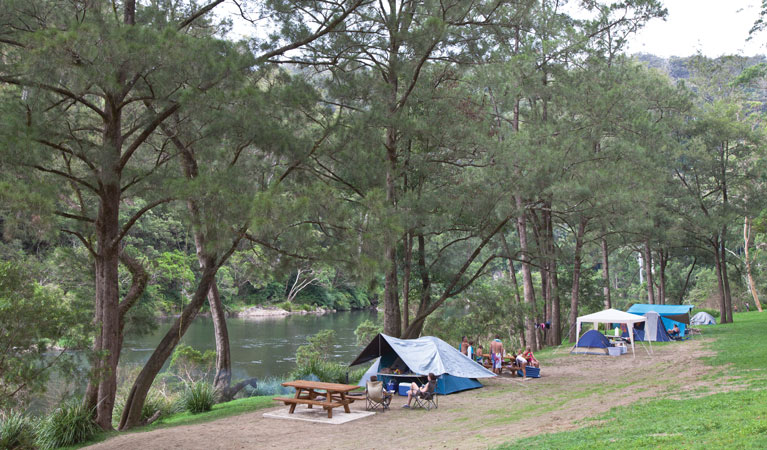Overview
For a riverside adventure filled with swimming, paddling, fishing and wildlife spotting, try Platypus Flat campground in Nymboi-Binderay National Park near Dorrigo.
| Number of campsites | 18 |
|---|---|
| Camping type | Tent, Camper trailer site, Caravan site, Don't mind a short walk to tent |
| Facilities | Toilets, unpowered sites, marked sites, barbecue facilities, picnic tables, carpark |
| What to bring | Drinking water, cooking water |
| Bookings | Book up to 12 people or 2 sites online. |
| Group bookings | School groups and Park Eco Pass holders can make a group booking enquiry. |
| Please note |
|
Platypus Flat campground is an idyllic setting among the tall trees and rugged granite gorges of Nymboi-Binderay National Park on the Dorrigo plateau. Overlooking the rainforest-lined river banks of Nymboida River, it’s an ideal spot for adventure-seekers who love kayaking, walking and fishing.
Located along the Moonpar Forest drive, pitch your tent and settle in before you explore this rugged country. Launch your canoe for a paddling trip along the beautiful river, or try a guided rafting or kayak adventure. In the heat of summer, the nearby swimming hole is excellent for a refreshing dip.
In the evening, stoke up a campfire in one of the fire pits and settle back for a wood-fired barbecue feast. If you’re keen to see some wildlife, grab a torch and look for tiger quolls, gliders and owls.
Map

Map legend

Local alerts
For the latest updates on fires, closures and other alerts in this area, see https://www.nationalparks.nsw.gov.au/camping-and-accommodation/campgrounds/platypus-flat-campground/local-alerts
Bookings
- National Parks Contact Centre
- 7am to 7pm daily
- 1300 072 757 (13000 PARKS) for the cost of a local call within Australia excluding mobiles
- parks.info@environment.nsw.gov.au
Operated by
- Coffs Harbour office
- Monday to Friday, 8.30am to 4.30pm.
- 02 6652 0900
- npws.coffscoast@environment.nsw.gov.au
- 4/32 Edgar St, Coffs Harbour NSW 2450
Park info
- in Nymboi-Binderay National Park in the North Coast region
Nymboi-Binderay National Park is always open but may have to close at times due to poor weather or fire danger.
Visitor info
All the practical information you need to know about Platypus Flat campground.
Getting there and parking
Platypus Flat campground is in Nymboi-Binderay National Park. To get there:
- From Dorrigo, travel north along Tyringham Road for 14km
- Turn right into Moonpar Road and continue 7km
- Turn left into Mills Road and follow the signs to the campground after 8km
Alternatively:
- From Dorrigo, travel north-east around 20km to Cascade
- Turn left into Moses Rock Road and continue 6km
- Turn left into Cedar Road and follow the signs to the campground after 9km
Road quality
- There is a steep descent into the campground.
- The access roads require 4WD vehicles.
- There is no long vehicle access into the campground. Access is not suitable for large caravans (over 4.5m).
- Unsealed roads are only suitable for off-road caravans
- Check the weather before you set out as the road to Platypus Flat campground can become boggy when it rains.
- Mixture of sealed and unsealed roads
Vehicle access
- All roads require 4WD vehicle
Weather restrictions
- 4WD required in wet weather
Parking
- Parking for 1 vehicle is permitted per campsite.
- For tent only campsites, parking is available in the carpark next to the camping area.
Weather, temperature and rainfall
Summer temperature
Average
18°C and 29°C
Winter temperature
Average
5°C and 20°C
Rainfall
Wettest month
March
Driest month
August
The area’s highest recorded rainfall in one day
388mm
Facilities
- Campsites are marked. Sites 1 to 6 are suitable for small caravans (under 15ft or 4.6m), camper trailers and campervans and tents. Sites 7 to 18 are suitable for tents.
- There is no drinking water at this campground. You can draw water from the Nymboida River, but you'll need to treat or boil it before drinking.
- No power or shower facilities are available at this campground.
- Rubbish bins are not available, please take all rubbish with you.
- There's no mobile phone service or telephone. The nearest mobile service is located around 8km away, at the intersection of Moonpar and Mills Roads. Coin-operated public phones are located at the villages of Cascade and Bostobrick.
Toilets
Composting toilets
- Non-flush toilets
Types of sites
- Unpowered sites
- Marked sites
Barbecue facilities
Each campsite has a wood barbeque with hot plate. The campground also has a small day-use picnic shelter and gas barbecues.
There may be a limited supply of firewood at this campground, so it’s a good idea to bring your own supply.
- Gas/electric barbecues (free)
- Wood barbecues
Picnic tables
Each campsite has a picnic table.
Carpark
Maps and downloads
Accessibility
Disability access level - no wheelchair access
Facilities at this campground are not wheelchair-accessible.
Permitted
- Chemical toilets are permitted, but contents are not to be emptied in the compost toilets or surrounding areas.
Fishing
- Fishing is permitted between 1 November and 31 July only. Fines may apply outside this period. A current NSW recreational fishing licence is required when fishing in all waters. In order to protect the diminishing numbers of endangered eastern freshwater cod, you're required to release them if caught.
Prohibited
- Amplified music is not permitted.
Gathering firewood
No firewood may be collected from the park. Some firewood is provided, but it's recommended you bring your own supply.
Generators
Generators are not permitted at this campground.
Pets
Pets and domestic animals (other than certified assistance animals) are not permitted. Find out which regional parks allow dog walking and see the pets in parks policy for more information.
Smoking
NSW national parks are no smoking areas.
Learn more
Platypus Flat campground is in Nymboi-Binderay National Park. Here are just some of the reasons why this park is special:
Ancient connections

Nymboi-Binderay National Park is the traditional Country of the Gumbaynggirr People and their ancient connection to this land is evident throughout the park. The park's landscape provided a rich source of food, medicine and shelter for Aboriginal people and features strongly in cultural knowledge and Dreaming stories. As you travel through this park, take some time to think about the people who lived here and their strong attachment to this ancient landscape and all it contains.
Animal kingdom

Nymboi-Binderlay has a diverse range of animals, including 68 types of mammal, 25 kinds of amphibian, 33 sorts of reptile and over 120 bird species; of these, at least 15 species are threatened. When you’re picnicking, camping or walking through the tallowwood and coachwood rainforests, be sure to keep your eyes open for the many native animals which call this place home.
- Moonpar Forest drive Moonpar Forest drive is a 75km scenic car touring route near Dorrigo. It’s a great day out and an ideal way to explore the walks, riverside picnic spots, and sights of Nymboi-Binderay and Cascade national parks.
- Norman Jolly picnic area Enjoy a picnic among tall old-growth trees and historic logging relics at Norman Jolly picnic area in Nymboi-Binderay National Park, not far from Dorrigo.
Waterworld

The Nymbodia River is a true highlight of Nymboi-Binderay National Park. The name of the park comes from Aboriginal language of the local Gumbaynggirr People; 'Nymboi' being their name for the river, and 'Binderay' meaning river. Rafting down the Nymboi River with an expert guide is an exhilarating experience and a fantastic way to take in the park's landscape.
- Coachwood loop track The Coachwood loop track is a short and easy walk that starts and finishes at the Norman Jolly picnic area in Nymboi-Binderay National Park.
- Moonpar Forest drive Moonpar Forest drive is a 75km scenic car touring route near Dorrigo. It’s a great day out and an ideal way to explore the walks, riverside picnic spots, and sights of Nymboi-Binderay and Cascade national parks.
Plants and animals protected in this park
Animals
-

Koala (Phascolarctos cinereus)
One of the most renowned Australian animals, the tree-dwelling marsupial koala can be found in gum tree forests and woodlands across eastern NSW, Victoria and Queensland, as well as in isolated regions in South Australia. With a vice-like grip, this perhaps most iconic but endangered Australian animal lives in tall eucalypts within a home range of several hectares.
-

Superb lyrebird (Menura novaehollandiae)
With a complex mimicking call and an elaborate courtship dance to match, the superb lyrebird is one of the most spectacular Australian animals. A bird watching must-see, the superb lyrebird can be found in rainforests and wet woodlands across eastern NSW and Victoria.
-

Southern boobook (Ninox novaeseelandiae)
The southern boobook, also known as the mopoke, is the smallest and most common native owl in Australia. With a musical 'boo-book' call that echoes through forests and woodlands, the southern boobook is a great one to look out for while bird watching.
Plants
-

Wonga wonga vine (Pandorea pandorana)
The wonga wonga vine is a widespread vigorous climber usually found along eastern Australia. A variation of the plant occurs in the central desert, where it resembles a sprawling shrub. One of the more common Australian native plants, the wonga wonga vine produces bell-shaped white or yellow flowers in the spring, followed by a large oblong-shaped seed pod.
-

Blueberry ash (Elaeocarpus reticulatus)
The blueberry ash is a rainforest shrub which produces blue olive-shaped berries and spectacular bell-shaped flowers, which often appear on the plant together. It is a tall slender shrub or small tree found in rainforest, tall eucalypt forest and coastal bushland in eastern NSW, south-east Queensland and Victoria.

